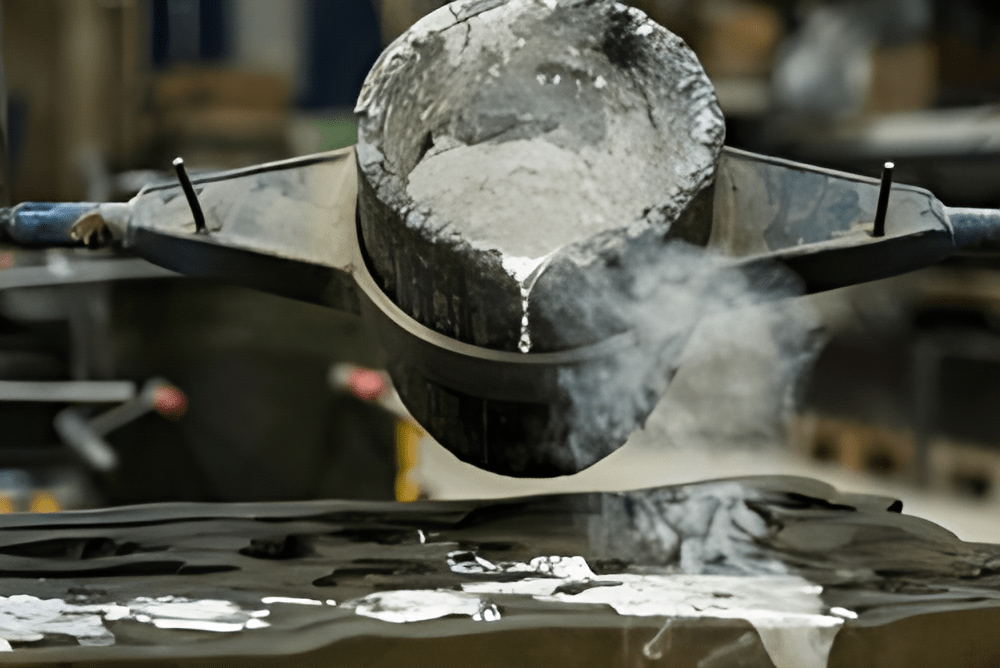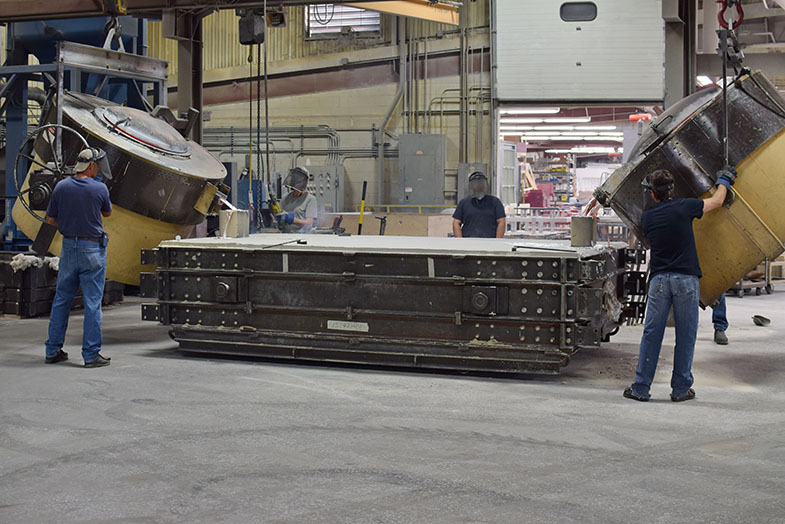The next big thing for Aluminum Foundry in global industries
Wiki Article
All Regarding Aluminum Foundry: Secret Makes Use Of and Its Influence On Item Growth
Aluminum foundries are crucial in modern manufacturing, particularly in sectors like vehicle and aerospace. They utilize sophisticated methods to produce lightweight, sturdy parts that enhance efficiency. The convenience of aluminum additionally lines up with sustainability initiatives, making it a preferred material. The continuous advancements in casting methods and their implications for product growth raising vital concerns. What future innovations might reshape the landscape of aluminum foundries and their applications?Review of Aluminum Foundries
Aluminum foundries act as critical facilities in the metalworking sector, concentrating on the casting of aluminum and its alloys. These facilities make use of numerous approaches, including sand casting, pass away casting, and financial investment casting, to transform raw aluminum right into usable kinds. Each casting method uses one-of-a-kind advantages, catering to different job demands ranging from tiny parts to huge structural aspects.The foundries run with a meticulous procedure that starts with melting aluminum, adhered to by pouring the liquified metal right into molds. After cooling, the castings undertake finishing processes, which might involve machining and surface treatment to satisfy precise requirements.
Quality control is vital, making certain that the final products meet sector requirements and consumer expectations. On top of that, aluminum foundries commonly highlight sustainability by reusing scrap aluminum, therefore minimizing waste and preserving sources. This commitment to efficient production and ecological obligation placements aluminum foundries as essential contributors to the production landscape.

Trick Applications of Aluminum Castings
Aluminum castings serve important duties in numerous industries, particularly in auto and aerospace fields. In the auto industry, they add to lightweight frameworks and effective performance. In a similar way, aerospace component production counts on aluminum castings for their toughness and corrosion resistance, crucial for high-performance applications.Automotive Market Applications
In the automobile sector, aluminum castings play a vital function in boosting vehicle performance and performance. These castings are extensively made use of for elements such as engine blocks, transmission housings, and suspension components. Their lightweight nature adds to minimized lorry weight, which consequently enhances fuel economic climate and handling. Additionally, aluminum's outstanding thermal conductivity permits effective warmth dissipation, vital for high-performance engines. The rust resistance of aluminum also extends the life-span of automobile components, reducing maintenance costs. In addition, advancements in casting modern technologies enable the manufacturing of intricate shapes, maximizing the style and capability of components. On the whole, aluminum castings are integral to contemporary auto design, supporting advancement and sustainability in car design.Aerospace Component Production
The aerospace sector significantly relies upon aluminum castings for a variety of vital components as a result of their beneficial homes. Lightweight yet strong, aluminum castings improve gas efficiency and total performance in airplane style. Parts such as engine mounts, structural structures, and landing gear are frequently generated making use of aluminum casting strategies, enabling manufacturers to achieve intricate geometries while keeping structural honesty. The high resistance to deterioration and thermal buildings of aluminum additionally add to the durability and reliability of aerospace components. In addition, innovations in casting technologies, such as precision casting and 3D printing, have expanded the abilities of aluminum in this field. Inevitably, aluminum castings play an important role in meeting stringent safety and security requirements and performance demands in contemporary aerospace applications.Benefits of Making Use Of Aluminum in Manufacturing
While many materials are readily available for production, aluminum attracts attention due to its special combination of residential or commercial properties that enhance effectiveness and performance. One considerable benefit of aluminum is its light-weight nature, which adds to reduced energy consumption and enhanced fuel performance in numerous applications. In addition, aluminum displays excellent rust resistance, extending the life expectancy of products and decreasing maintenance prices. Its high thermal and electrical conductivity makes it ideal for warmth exchangers and electrical parts, while its malleability permits functional layouts and elaborate shapes.Furthermore, aluminum is recyclable, promoting sustainability in producing procedures. This reusability not only saves resources however also reduces the carbon footprint related to production. The flexibility of aluminum to numerous alloys further improves its utility in varied markets, from auto to customer electronic devices. Collectively, these attributes make aluminum an ideal selection for makers seeking to stabilize performance, cost-effectiveness, Aluminum Foundry and ecological responsibility.
Advancements in Casting Techniques
Recent developments in casting strategies have actually significantly transformed the aluminum foundry sector. The integration of 3D printing technology has enabled more intricate styles, while improved alloy solutions enhance efficiency and durability. These technologies are driving efficiency and increasing the applications of aluminum in numerous fields.3D Printing Assimilation

Improved Alloy Solutions
Innovations in aluminum factory innovation have resulted in the growth of enhanced alloy formulations that boost casting efficiency and product buildings. These cutting-edge formulations typically include components such as silicon, magnesium, and copper, which maximize toughness, ductility, and deterioration resistance. By fine-tuning the make-ups, makers can attain certain attributes tailored to varied applications, from automotive to aerospace sectors. In addition, these improved alloys promote better fluidity during the casting process, reducing issues and enhancing surface finish. Consequently, the effectiveness of manufacturing is greatly raised while maintaining rigorous high quality requirements. This advancement in alloy growth not only streamlines production yet likewise supports the production of lighter, stronger components, inevitably advancing item growth and efficiency.Influence on Aerospace and Automotive Industries
The noteworthy influence of aluminum foundries on the aerospace and vehicle markets can not be overemphasized. Aluminum alloys, understood for their light-weight and high toughness, have actually reinvented the design and manufacturing processes in both markets. In aerospace, the reduction in weight directly associates to fuel effectiveness, allowing for longer trips and reduced exhausts. Components such as aircraft frames, wings, and engine parts profit from aluminum's excellent fatigue resistance and corrosion resistance.In the automobile market, aluminum foundries add to the production of lighter automobiles, boosting efficiency and fuel economic situation while meeting rigid ecological laws. Making use of aluminum in engine blocks, body panels, and wheels has enhanced substantially, driven by customer demand for a lot more efficient cars. Furthermore, innovations in casting strategies have improved the precision and capability of parts, making it possible for producers to develop more integrated and complex styles, thus cultivating innovations in both industries.
Sustainability Practices in Aluminum Foundries
Aluminum foundries are significantly embracing sustainability practices to decrease their environmental footprint while satisfying the expanding needs of the aerospace and vehicle markets. These techniques include the implementation of energy-efficient technologies, such as electric melting heating systems and progressed warm recuperation systems, which considerably reduced energy intake (Aluminum Foundry). Additionally, numerous foundries are prioritizing making use of recycled aluminum, which requires much less energy and causes lowered greenhouse gas emissions compared to primary aluminum manufacturingWater conservation initiatives are additionally obtaining grip, with foundries using closed-loop systems to minimize water use and stop contamination. Additionally, waste monitoring methods, consisting of reusing scrap and decreasing contaminated materials, add to an extra sustainable operation. By embracing these practices, aluminum foundries not only boost their competition however additionally straighten with global sustainability goals, inevitably supporting a circular economic situation and promoting technology in eco pleasant production processes.
Future Patterns in Aluminum Spreading Technology
As the demand for light-weight and long lasting materials continues to rise, developments in casting innovation are positioned to reshape the aluminum market. Advanced methods such as 3D printing and automated casting procedures are obtaining traction, allowing for more complex geometries and lowered product waste. The combination of expert system and artificial intelligence is also boosting high quality control and process optimization, minimizing flaws and improving performance.The development of new aluminum alloys is broadening the application variety of cast products, making them suitable for industries from vehicle to aerospace. Improved recycling approaches are expected to further reduce ecological effects, straightening with international sustainability objectives.
Additionally, the usage of wise sensing units in casting procedures is prepared for to allow real-time monitoring, making certain better precision and consistency. These trends indicate a transformative period in aluminum casting innovation, allowing producers to satisfy progressing market needs while prioritizing sustainability and advancement.
Frequently Asked Inquiries
Just How Is Aluminum Recycled After Use in Products?
Aluminum reusing involves gathering, arranging, and melting made use of aluminum products (Aluminum Foundry). The liquified steel is then cast into new types, lowering energy usage and maintaining all-natural resources, making it an efficient and lasting process for aluminum recuperationWhat Precaution Are Carried Out in Aluminum Foundries?
Precaution in aluminum foundries include correct ventilation systems, individual protective devices, normal safety training, devices upkeep methods, and emergency action plans, all focused on lessening dangers related to high temperature levels and harmful products during manufacturing.Exactly How Do Aluminum Foundries Make Certain Quality Assurance?
Aluminum foundries carry out extensive quality assurance procedures, including product assessments, temperature level monitoring, and dimensional checks. These procedures guarantee product uniformity, decrease defects, and stick to market requirements, ultimately enhancing consumer contentment and functional efficiency.What Are Common Challenges Faced by Aluminum Foundries?
Aluminum foundries commonly deal with challenges such as keeping constant quality, handling production costs, making certain prompt shipment, resolving equipment maintenance, and adapting to advancing industry guidelines. These aspects can considerably impact general functional efficiency and productivity.How Does Aluminum Spreading Affect Item Weight?
Aluminum casting substantially decreases product weight as a result of aluminum's reduced density compared to other steels - Aluminum Foundry. This light-weight particular improves design versatility, boosts gas efficiency in transportation applications, and provides advantages in numerous sectors requiring weight-sensitive componentsReport this wiki page